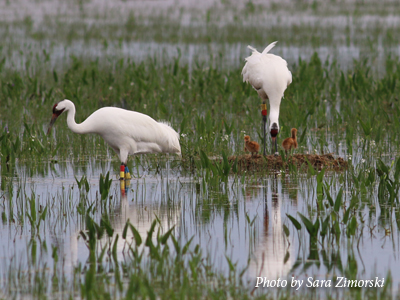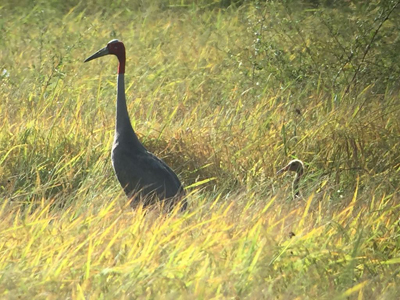The year 2016 marked the fledging of two memorable wild cranes – a Whooping Crane in Louisiana and an Eastern Sarus Crane in Buriram, Thailand. These young cranes are the result of reintroduction programs for each species that began approximately five years ago, with the goal of returning the cranes to the wild in both regions. In 1950, a single Whooping Crane was the last original resident of its species in Louisiana, while thirty years later, in 1984, the last Eastern Sarus Crane was reported in Thailand.

In recent decades captive populations of both species were respectively established in the United States and Thailand. From captive breeding between 2010-2015, about 70 birds were provided for release for both the Louisiana and Thailand reintroductions. Today there are about 40 birds in each population. This loss of about forty percent of the young cranes approximates mortality rates in the original wild population of Whooping Cranes, while mortality rates of wild Eastern Sarus Cranes are unknown.
In Louisiana the captive cranes were released from a holding pen into natural wetlands of the White Lake Wetlands Conservation Area, while in Buriram the cranes were released into the shallows of back-waters of two reservoirs. To the north of the wetlands in Louisiana, are wide expanses of fields dedicated to crayfish and rice, while the reservoirs in Buriram are bordered by rice fields with scattered trees.

This year, five pairs of Whooping Cranes made their nests in flooded areas of crayfish ponds or small wetlands within the agricultural area, while in Thailand, two pairs nested in wetlands of the reservoirs, and five pairs nested in flooded areas of rice fields. From the five nesting pairs of Whooping Cranes, two pairs laid infertile eggs, two pairs lost fertile eggs to embryo death, and one pair hatched two chicks. From the eight nesting attempts of Eastern Sarus Cranes, one pair only built a nest but did not lay eggs, one nest was lost to flooding, eggs in two nests were lost to predation from crows, and eggs in three nests hatched chicks. One chick survived to fledge in each population and continues to thrive. With increased breeding experience, we are hopeful that more pairs will be successful in future years.

The Whooping Crane and Eastern Sarus Crane families feed in rice fields ripe for harvest. The tall rice plants provide excellent cover and seeds, while the wet soils likely are teeming with small aquatic animals that fuel ample protein for fast-growing chicks. Considering the huge acreages of rice in both areas, the damage from cranes is likely minimal. If the cranes and farmers can peacefully coexist, the future for cranes is bright!
The Patuxent Wildlife Research Center in Maryland, the International Crane Foundation in Wisconsin, and the Calgary Zoo in Canada, produced the cranes for release in Louisiana, while the Korat Zoo in Thailand produced the Eastern Sarus Cranes for release. In Louisiana, the release program is administered by the Louisiana Department of Wildlife and Fisheries, and the United States Fish and Wildlife Cooperative Unit at Louisiana State University. The Zoological Park Association of Thailand supported and guided the efforts of Korat Zoo both in the production, releases and monitoring of Eastern Sarus Cranes. All participants are to be congratulated for recent fledglings!
Since the late 1970s, when the International Crane Foundation received the last two captive males of the Louisiana non-migratory population of Whooping Cranes, and since 1984 when Thai colleagues expressed an interest in the reintroduction of Eastern Sarus Cranes, we have promoted efforts in both regions.
Finally political and biological hurtles were overcome, and releases initiated. It brought me great joy to observe the young cranes in Louisiana and Buriram with their parents this autumn.
 Story submitted by Dr. George Archibald, International Crane Foundation Co-founder and Senior Conservationist.
Story submitted by Dr. George Archibald, International Crane Foundation Co-founder and Senior Conservationist.
